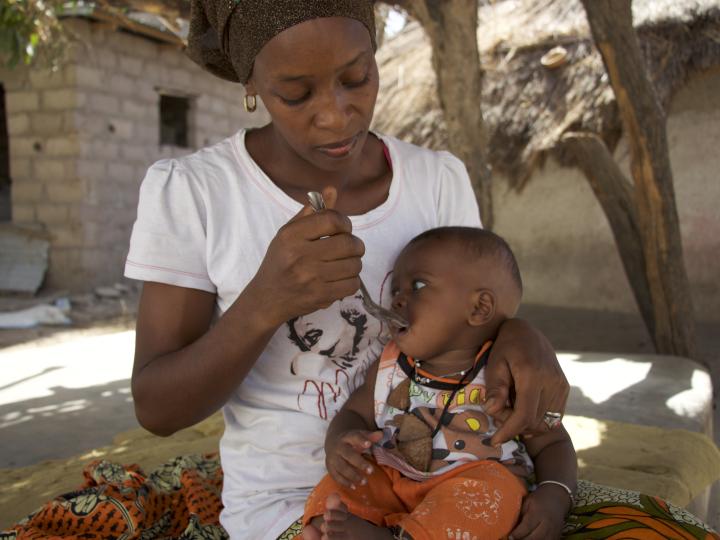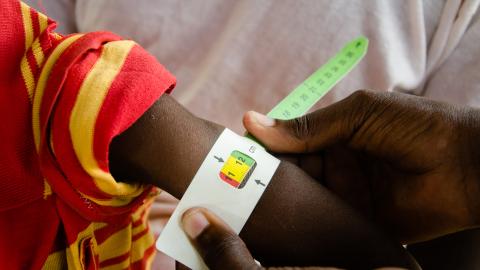
Complementary Feeding
From about six months of age, an infant’s nutritional needs exceed what breastmilk alone can supply. Complementary foods should therefore be introduced while continuing breastfeeding up to two years or beyond.
Why it matters
The period from 6–23 months is critical for growth, brain development, and establishing healthy eating patterns for life. Poor complementary feeding is a major contributor to stunting, micronutrient deficiencies, acute malnutrition, and long-term health disadvantages.
Key practices for quality complementary feeding
- Timing: Begin complementary foods at around six months of age, in addition to breastmilk.
- Dietary adequacy and diversity: Ensure frequent feedings of nutrient-rich foods including animal-source foods (meat, fish, eggs), pulses, nuts, seeds, fruits, and vegetables. Limit reliance solely on starchy staples.
- Meal frequency and consistency: For 6–8 month-olds feed 2 to 3 times a day, increasing to 3 to 4 meals (plus 1 to 2 snacks) daily for children 9–23 months, gradually moving toward family-meals appropriate for their age and abilities.
- Responsive feeding: Feed directly and assist the child; pay attention to hunger and satiety cues; encourage but never force a child to eat; create a positive feeding environment.
- Food safety and hygiene: Ensure clean hands, utensils, and safe preparation/storage; avoid giving foods or drinks of poor nutritional value (for example sugary soft drinks or excessive juice) which may displace nutritious options.
- Use of fortified foods or supplements where needed: In contexts where locally available foods cannot provide all nutrients, consider carefully designed fortified products or supplements (for example multiple-micronutrient powders or small-quantity lipid-based nutrient supplements) as part of a broader strategy, not as substitutes for diverse diets.
- Continuation of breastfeeding: Breastmilk remains an important source of nutrients after six months and should continue for up to two years or beyond, alongside complementary foods.
Our role
We support communities and caregivers to adopt optimal complementary-feeding practices by:
- providing counselling, training, and community-based behaviour change communication;
- promoting access to nutrient-rich, diverse foods, and animal-source foods;
- integrating complementary feeding into our broader child-nutrition, health, and development programmes;
- tailoring approaches for fragile, humanitarian, and food-insecure settings where special attention is needed.
By strengthening complementary feeding within the critical 6– 23-month window, we can help reduce child undernutrition, support healthy growth and development, and break cycles of disadvantage.
Sources
- UNICEF Infant and Young Child Feeding provides global status updates on country-level infant and young child feeding (IYCF) trends.
- WHO Complementary Feeding
- WHO Infant and Young Child Feeding
- WHO Guideline for complementary feeding of infants and young children 6–23 months of age
- UC Davis SQ-LNS Information Brief
- Emergency Nutrition Network Field Exchange 72, Summary of WHO Guideline for complementary feeding of infants and young children 6–23 months of age

Fortified Complementary Foods
"Nutrition is the basis of all our interventions with the children... if we don’t address adequately the nutritional needs of the children, our interventions may be jeopardised and the desired impact on the children’s condition jeopardised... Addressing the nutritional needs of our children means that we will be targetting the child in the context of his or her family and his or her community."
- Wesley Charles, former National Director, World Vision Haiti
Often, locally available foods do not have sufficient micronutrient content to meet infants’ daily dietary requirements and centrally fortified foods are not available or affordable. World Vision promotes fortification of complementary foods, mainly through home fortification with micronutrient powders.
Better Practices examples of fortified complementary foods are provided under Iron for Young Children.
* Source: Disease Control Priorities Project. Fact Sheet: Eliminating malnutrition could reduce poor countries’ disease burden by one-third, July 2007, http://www.bvsde.paho.org/texcom/nutricion/DCPP-Nutrition.pdf